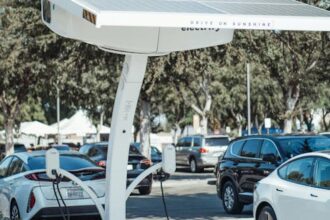As climate urgency reaches a tipping point, breakthrough technologies are emerging as humanity’s best hope for averting catastrophe. From AI-powered carbon capture to floating solar farms, the green tech revolution is transforming industries and reshaping our relationship with the planet.
The clock is ticking louder than ever. With global temperatures rising and extreme weather events becoming the norm rather than the exception, the race to develop and deploy climate-saving technologies has reached fever pitch. What was once considered the domain of environmental activists and academic researchers has become the epicenter of the world’s most urgent innovation race.
The green technology and sustainability market, valued at $25.47 billion in 2025, is projected to explode to $73.90 billion by 2030—a staggering compound annual growth rate of 23.7%. This isn’t just economic growth; it’s a testament to humanity’s determination to engineer its way out of climate crisis.
But behind these numbers lies a story of remarkable human ingenuity. From laboratories in Silicon Valley to pilot projects in remote corners of the world, scientists, engineers, and entrepreneurs are developing technologies that could fundamentally alter our planet’s trajectory. Climate tech is evolving quickly, with innovations in renewable energy, industrial decarbonization, and carbon capture, driven by public concern, government incentives, and corporate interest.
The revolution isn’t coming—it’s here, and it’s happening faster than anyone predicted.
Carbon Capture: Pulling Victory from the Jaws of Defeat
Perhaps no technology embodies the audacity of the green tech revolution quite like carbon capture and storage (CCS). The concept is as ambitious as it sounds: literally sucking carbon dioxide out of the atmosphere and either storing it underground or transforming it into useful products.
Carbon capture and storage technology pulls carbon from the atmosphere and uses it to make synthetic fuel. While currently expensive and relatively small-scale, a study by Stanford University predicts that the costs of this technology could be reduced by a multiple of six.
Direct Air Capture Breakthroughs
Companies like Climeworks in Switzerland and Carbon Engineering in Canada have moved beyond laboratory experiments to commercial-scale operations. Climeworks’ Orca plant in Iceland can capture 4,000 tons of CO2 annually—equivalent to removing 870 cars from the road for a year. But that’s just the beginning. The company plans to scale up to megaton capacity by 2030, a thousand-fold increase that would make meaningful dents in global emissions.
The technology works by using massive fans to draw air through filters containing chemical sorbents that bind with CO2 molecules. Once saturated, the filters are heated to release pure CO2, which is then either stored permanently underground or converted into products like concrete, plastics, or even jet fuel.
Industrial Carbon Conversion
Even more revolutionary are technologies that don’t just store captured carbon but transform it into valuable products. Boston-based LanzaTech has developed a process that converts industrial waste gases into ethanol, which can then be used to make everything from polyester clothing to jet fuel. Their technology is already operational in steel mills and oil refineries, turning pollution into profit.
Meanwhile, companies like CarbonCure are injecting captured CO2 into concrete during manufacturing, creating stronger building materials while permanently sequestering carbon. The concrete industry, responsible for about 8% of global emissions, could become carbon-negative rather than carbon-positive.
Renewable Energy: Beyond Wind and Solar
While wind and solar power grab headlines, the renewable energy revolution extends far beyond traditional technologies. Some of the most impactful climate tech trends in renewable energy include decentralized energy systems or microgrid systems where consumers are empowered to generate and distribute power, and floating solar farms like the 320 MW plant in China using water bodies that are not in use.
Floating Solar: Seas of Possibility
Floating solar installations, or “floatovoltaics,” represent one of the most promising frontiers in renewable energy. These systems deploy solar panels on bodies of water, from reservoirs and lakes to coastal areas. The advantages are multiple: water cooling increases panel efficiency, the installations reduce water evaporation, and they don’t compete with land needed for agriculture or development.
China leads the world with massive floating solar farms, including a 150 MW installation that covers 200 hectares of a former coal mining subsidence area. The irony is poetic—renewable energy literally floating on the flooded remains of fossil fuel extraction.
Perovskite Solar Cells: The Next Generation
While silicon solar panels have driven costs down dramatically, perovskite solar cells promise to revolutionize the industry again. These next-generation cells can achieve efficiency rates above 31% compared to silicon’s 26%, and they can be manufactured using lower-temperature processes and even printed on flexible substrates.
Oxford PV, a spin-out from Oxford University, has developed perovskite-on-silicon tandem cells that could make solar installations 20% more efficient while reducing costs. The technology could transform everything from building-integrated photovoltaics to solar-powered vehicles.
Offshore Wind Renaissance
Offshore wind technology is experiencing its own revolution. Floating wind turbines, tethered to the ocean floor rather than fixed to it, can access deeper waters where winds are stronger and more consistent. Norway’s Hywind Scotland, the world’s first commercial floating wind farm, has consistently outperformed expectations, generating electricity at capacity factors above 50%.
The potential is enormous. The International Energy Agency estimates that offshore wind could generate more than 420,000 TWh per year worldwide—more than 18 times current global electricity demand.
Smart Grids and Energy Storage: The Intelligence Revolution
The renewable energy revolution faces a fundamental challenge: the sun doesn’t always shine, and the wind doesn’t always blow. Smart grids and advanced energy storage technologies are solving this intermittency problem while creating more resilient, efficient energy systems.
AI-Powered Grid Management
Consider the world’s first zero-carbon factory in Sichuan province, where AI monitors data in real-time and algorithms optimize energy consumption, enabling the operating company to reportedly reduce carbon emissions by 400,000 tons annually.
Smart grids use artificial intelligence and machine learning to predict energy demand, optimize distribution, and integrate renewable sources seamlessly. Pacific Gas & Electric’s grid modernization program uses AI to predict equipment failures before they occur, reducing outages by 30% while enabling higher levels of renewable integration.
Google’s DeepMind has demonstrated that AI can reduce energy consumption in data centers by up to 40%, and similar technologies are being deployed across industrial facilities worldwide. The key is predictive optimization—using AI to anticipate energy needs and adjust systems proactively rather than reactively.
Battery Storage Breakthroughs
While lithium-ion batteries have become cheaper and more efficient, next-generation storage technologies promise even greater improvements. Iron-air batteries, developed by companies like Form Energy, can store electricity for up to 100 hours at costs competitive with natural gas peaker plants. These systems could enable renewable energy to provide reliable baseload power.
Flow batteries, which store energy in liquid electrolytes, offer virtually unlimited cycling without degradation. China’s Dalian Vanadium Flow Battery Energy Storage Station, the world’s largest of its kind, demonstrates how these systems can provide grid-scale storage for renewable integration.
Vehicle-to-Grid Integration
Electric vehicles are transforming from energy consumers to energy resources. Vehicle-to-grid (V2G) technology enables EVs to feed stored electricity back into the grid during peak demand periods, effectively turning millions of car batteries into a distributed energy storage network.
Nissan’s LEAF-to-Home system in Japan has proven the concept during natural disasters, with EVs powering entire homes for days. As EV adoption accelerates, this distributed storage capacity could revolutionize grid stability and renewable integration.
Sustainable Materials: Reimagining Manufacturing
The green tech revolution extends beyond energy into materials science, where innovations are replacing carbon-intensive materials with sustainable alternatives that can actually improve performance while reducing environmental impact.
Green Construction Materials
Building materials are also going green. Innovations include energy-efficient cement and recycled concrete, which significantly reduce carbon footprints in construction. The fashion industry is turning to sustainable fabrics like organic cotton, bamboo, and even recycled ocean plastics.
The cement industry alone accounts for about 8% of global CO2 emissions, but companies like CarbonCure and Solidia Technologies are developing alternatives. CarbonCure’s process injects captured CO2 into concrete, making it stronger while permanently sequestering carbon. Solidia’s technology replaces limestone with sand and clay in cement production, reducing emissions by up to 70%.
Mycelium-based materials, grown from mushroom roots, are replacing plastic packaging, leather, and even building insulation. Ecovative Design’s mushroom-based packaging has been adopted by companies like Dell and IKEA, while MycoWorks is producing high-end leather alternatives from mushroom mycelium.
Bioplastics and Circular Materials
Traditional plastics, derived from petroleum, are being replaced by bioplastics made from plant materials, algae, and even food waste. NatureWorks produces PLA (polylactic acid) plastic from corn starch, creating bottles, packaging, and 3D printing filament that can biodegrade in industrial composting facilities.
Even more revolutionary are technologies that create plastics from captured CO2. Newlight Technologies has developed AirCarbon, a plastic made from methane and CO2 that actually removes more greenhouse gases from the atmosphere than it emits during production. The material is being used to make everything from phone cases to fashion accessories.
Recycled Ocean Plastic
The fashion industry’s embrace of recycled ocean plastic represents both environmental cleanup and material innovation. Adidas has produced over 30 million pairs of shoes made from recycled ocean plastic, collected by partners like Parley for the Oceans. Each pair incorporates plastic equivalent to 11 bottles rescued from beaches and coastal communities.
Transportation Revolution: Beyond Electric Vehicles
While electric vehicles capture headlines, the green tech revolution in transportation encompasses everything from hydrogen fuel cells to sustainable aviation fuels, each tackling different pieces of the decarbonization puzzle.
Hydrogen Economy Emergence
Green hydrogen, produced using renewable electricity to split water molecules, is emerging as the fuel of the future for heavy industry and long-distance transportation. Unlike batteries, hydrogen can power massive trucks, ships, and aircraft for thousands of miles with quick refueling times.
Japan leads global hydrogen development with plans to import hydrogen from Australia using specially designed tankers. European countries are building hydrogen highways with refueling stations every 150 kilometers. In California, hydrogen fuel cell trucks are beginning to replace diesel vehicles in freight corridors.
Sustainable Aviation Fuels
Aviation, one of the hardest sectors to electrify, is turning to sustainable aviation fuels (SAF) made from everything from used cooking oil to algae. United Airlines has committed to purchasing 1.5 billion gallons of SAF, while Boeing has certified its aircraft to run on 100% SAF blends.
LanzaTech’s technology converts industrial waste gases into jet fuel, while companies like Fulcrum BioEnergy transform municipal solid waste into aviation fuel. These technologies could reduce aviation emissions by up to 80% compared to conventional jet fuel.
Electric Maritime Transport
Battery-electric ferries are already operating in Norway, Denmark, and other countries, proving that marine electrification is feasible for short routes. For longer distances, ammonia fuel cells and hydrogen power systems are being developed by companies like MAN Energy Solutions and Wärtsilä.
Maersk, the world’s largest container shipping company, has ordered 19 vessels capable of running on green methanol, signaling the industry’s commitment to decarbonization.
Agricultural Innovation: Feeding the Future Sustainably
Agriculture faces a dual challenge: feeding a growing global population while reducing environmental impact. Green tech innovations are addressing both challenges simultaneously through precision agriculture, alternative proteins, and regenerative farming techniques.
Precision Agriculture and AI
Artificial intelligence and sensor networks are revolutionizing farming efficiency. John Deere’s autonomous tractors use GPS and computer vision to plant, fertilize, and harvest with precision impossible for human operators. The result is reduced chemical usage, improved yields, and lower environmental impact.
Satellite imagery and drone surveillance enable farmers to monitor crop health, soil moisture, and pest populations in real-time. Companies like Planet Labs provide daily satellite images that help farmers optimize water usage and identify problems before they become catastrophic.
Vertical and Indoor Farming
Vertical farms, growing crops in stacked layers under LED lights, can produce 390 times more food per square foot than traditional farming while using 95% less water. AeroFarms in New Jersey grows leafy greens year-round without soil, pesticides, or weather dependence.
These systems can be located in urban areas, reducing transportation emissions while providing fresh produce to food deserts. Singapore, which imports 90% of its food, is investing heavily in vertical farming to improve food security.
Alternative Proteins
Plant-based meats have evolved from niche products to mainstream alternatives. Beyond Meat and Impossible Foods use plant proteins to create products nearly indistinguishable from animal meat, requiring 99% less land and generating 90% fewer emissions than beef production.
Cultivated meat, grown from animal cells without raising animals, represents the next frontier. Companies like UPSIDE Foods and GOOD Meat have received regulatory approval to sell lab-grown chicken in the United States, marking the beginning of a potential transformation in protein production.
The Economic Engine of Change
The green technology industry experienced growth of 8.90% last year, indicating steady development across over 3,100 companies. The sector supports a workforce of 244,500 employees, with growth of 14,500 employees in the last year.
This job creation story extends far beyond Silicon Valley startups. Traditional manufacturing regions are becoming clean energy hubs as companies retool factories for solar panels, wind turbines, and electric vehicle batteries. The Inflation Reduction Act in the United States has triggered over $200 billion in announced clean energy investments, creating jobs in states that previously depended on fossil fuel industries.
Investment Flows and Market Dynamics
AI, mealworms, aerospace, carbon capture: They’re all innovative approaches companies are taking to try to stop the effects of climate change. A new analysis of the world’s top greentech companies demonstrates the diversity of organizations fighting climate change.
Venture capital investment in climate tech reached record levels in 2024, with over $40 billion invested globally. Unlike previous cleantech booms, current investments are focused on commercially viable technologies with clear paths to profitability. Companies like Tesla have proven that sustainable technologies can be both environmentally beneficial and extremely profitable.
Corporate purchasing power is driving market transformation. Microsoft has committed to being carbon negative by 2030 and removing all historical emissions by 2050. Amazon’s Climate Pledge has attracted over 400 companies committed to net-zero emissions by 2040, creating massive demand for clean technologies.
Global Leaders and Emerging Markets
China’s Green Tech Dominance
China has emerged as the global leader in manufacturing clean energy technologies, producing over 80% of the world’s solar panels and dominating the wind turbine and electric vehicle battery markets. Chinese companies like BYD and CATL are setting global standards for electric vehicle technology and energy storage.
However, China’s leadership extends beyond manufacturing to innovation. Chinese companies are pioneering technologies like floating solar farms, high-voltage transmission systems, and next-generation nuclear reactors. The country’s commitment to carbon neutrality by 2060 has unleashed unprecedented investment in clean technologies.
European Innovation Leadership
Europe leads in several key areas, particularly offshore wind, hydrogen technology, and sustainable aviation fuels. Denmark generates over 50% of its electricity from wind power, while Norway’s hydroelectric and renewable resources have made it a leader in green hydrogen production.
European Union policies, including the Green Deal and carbon pricing mechanisms, have created strong incentives for clean technology development and deployment. The result is a thriving ecosystem of cleantech companies and research institutions.
Emerging Market Leapfrogging
Developing countries are increasingly adopting clean technologies directly, skipping older, more polluting alternatives. India’s solar capacity has increased from 2.6 GW in 2014 to over 70 GW in 2024, making it one of the world’s fastest-growing solar markets.
African countries are deploying mini-grids powered by solar and battery storage to electrify rural communities, while Latin American countries are becoming leaders in sustainable agriculture and forest conservation technologies.
Challenges and Barriers: The Road Ahead
Despite remarkable progress, significant challenges remain in scaling green technologies to the levels needed for climate stabilization.
Scaling Manufacturing
Many promising technologies remain expensive because they haven’t achieved manufacturing scale. Perovskite solar cells, direct air capture, and green hydrogen all require massive production scale-up to achieve cost competitiveness. This requires not just technological development but also supply chain development, workforce training, and manufacturing infrastructure.
Grid Integration and Storage
Integrating high levels of renewable energy requires extensive grid modernization and energy storage deployment. Many regions lack the transmission infrastructure needed to move renewable energy from generation sites to population centers. Energy storage costs, while declining rapidly, remain a barrier to achieving 100% renewable electricity systems.
Policy and Regulatory Frameworks
Inconsistent policies across jurisdictions create uncertainty for clean technology investments. Carbon pricing, renewable energy standards, and technology incentives vary widely, creating advantages for some regions while disadvantaging others. Streamlined permitting and consistent long-term policies are essential for continued progress.
Social Acceptance and Transition Management
The green tech revolution must address social equity and worker transition concerns. Communities dependent on fossil fuel industries require support and alternative economic opportunities. Environmental justice considerations must ensure that clean technology benefits reach all communities, not just wealthy ones.
The Path Forward: Systemic Transformation
The green tech revolution represents more than individual technologies—it’s a systemic transformation of how humanity produces energy, makes materials, grows food, and moves people and goods. Future trends in green technology innovation include carbon capture and storage, renewable energy storage, smart grids, electric transportation, and sustainable agriculture solutions, with an increasing focus on circular economies and decentralized power generation.
Circular Economy Integration
The most successful green technologies work within circular economy principles, where waste from one process becomes input for another. Industrial symbiosis, where different industries share resources and waste streams, can dramatically improve efficiency while reducing environmental impact.
Digital-Physical Convergence
The convergence of digital technologies with physical systems—often called “digitalization” or “Industry 4.0″—enables unprecedented optimization of resource use. AI-powered systems can optimize everything from building energy consumption to supply chain logistics, reducing waste while improving performance.
Systems Thinking
Rather than optimizing individual technologies in isolation, the green tech revolution requires systems thinking that considers interactions between energy, transportation, buildings, agriculture, and manufacturing. Smart cities that integrate renewable energy, electric transportation, efficient buildings, and waste recycling demonstrate this holistic approach.
Conclusion: Accelerating Toward a Sustainable Future
The green tech revolution is no longer a distant aspiration—it’s a present reality transforming industries, creating jobs, and offering genuine hope for addressing climate change. Empirical results show that a 1% rise in renewable energy consumption, technological innovations, and institutional quality reduces carbon emissions by 0.144%, 0.189%, and 0.257%, respectively.
The technologies exist. The investments are flowing. The policies are emerging. What remains is the challenge of scaling these innovations quickly enough to address climate urgency while ensuring that the benefits reach all communities and regions.
The next decade will determine whether humanity can deploy green technologies fast enough to avoid catastrophic climate change. The early indicators are encouraging: costs are falling, performance is improving, and adoption is accelerating faster than most experts predicted just a few years ago.
From AI-powered carbon capture facilities to floating solar farms to mushroom-based materials, the innovations fighting climate change represent humanity at its most creative and determined. The green tech revolution isn’t just about saving the planet—it’s about building a more prosperous, equitable, and sustainable future for all.
The race against climate change continues, but for the first time in decades, humanity has the tools to win it. The question isn’t whether we can develop the technologies needed to address climate change—we already have. The question is whether we can deploy them quickly enough, at sufficient scale, with adequate support for affected communities and workers.
The green tech revolution offers not just environmental salvation but economic opportunity, technological leadership, and moral purpose. As the market projections show, this isn’t just good for the planet—it’s good business. The companies, countries, and communities that embrace this transformation will thrive in the 21st century. Those that resist will be left behind by the most important technological revolution of our time.
For the latest developments in green technology, visit the International Renewable Energy Agency (IRENA), explore climate innovations at MIT Technology Review Climate, and follow investment trends through BloombergNEF. Stay informed about policy developments through the International Energy Agency (IEA).








